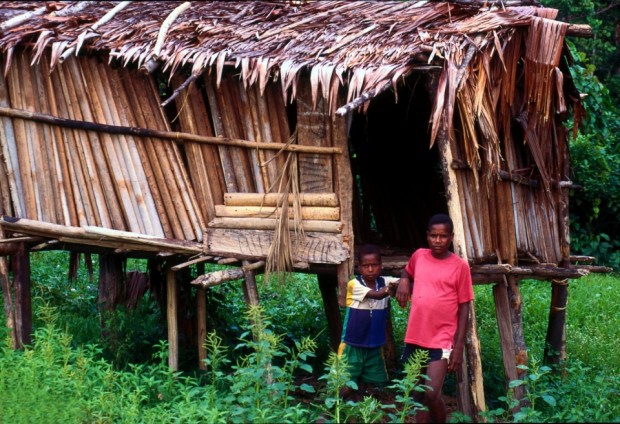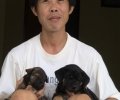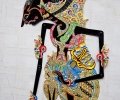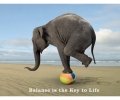My Primary Health Center
To solve the problem of unequal distribution of doctors, the Government compelled all new doctors to register and to work for it. The new doctors could choose one province where they want to work. The 27 provinces were classified as non-remote, remote, and very remote. The doctors would receive a higher salary and a shorter period of duty: one year for very remote, three years for non-remote. On completing the duty, they will be allowed to have their own private practice and to study specialization.
Better incentive and shorter period of duty did not make Papua (‘very remote’) the preferred province; in fact, it was the most avoided province by new doctors. Working in the jungle with primitive people was not a dream, but a nightmare for the majority of new doctors. To me, Papua was my ideal world, the world of adventure.
Reluctantly I registered at the Provincial Health Office in Yogyakarta. Within less than a week—very surprising speed—I was scheduled to have preparation training for government civil servant in Jakarta. There were about 60 doctors attended the training, and I was the only one who chose Papua. I was late for two days but the committee did not mind to accept me.
The training was a formality. All passed the test. One day before it finished, the certificates had been ready with the airline tickets for the doctors choosing outside Java and Bali. The date was one day after the last day of the training. They wanted us, especially for very remote provinces, to go ASAP. Very unusual service from the Government. However, I managed to change the departure date without paying extra fee. My stuff was still in Yogyakarta.
The second arrival was easy. AMA had arranged transportation and accommodation for me. Pater Ton paid all. The following day I reported to the Provincial Health Department in Kota Raja. The Boss was not available until three days later.
“What! You want to work for a private organization? No way!” the Boss yelled at me. Doctor Panjaitan is a Bataknese from North Sumatera. They always speak like angry people, even the kind ones. He read my file on his desk, left, and returned with his executive secretary, a Javanese man.
“Why do you want to work in Bayun?” Boss asked me. Dead! I had not prepared the answer because I thought it would be no problem to get permission working in the interior with the Mission. Wrong answer would be a disaster; he was well known for being rough.
“Because that area is difficult and interesting.” He roared with laughter. I must have given him wrong answer.
“You are weird,” said he. “Other doctors ask me for assignment in Jayapura or other big towns. You asked for a difficult area.” I did not care of being called ‘weird’; I was used to it. The most important was he signed my assignment letter.
He asked his secretary whether there was a Puskesmas, primary health center, in the district of Casuarinen Coast. I was very sure that he had no idea where it was on the map. Daryanto, the secretary, left the office and returned with a file folder.
“There was, Sir. In Pirimapun,” he informed Boss.
“How many staff there?”
“Two, Sir. One local nurse and one local nurse assistant.”
“What is the number of population?”
“18,000 people, Sir.”
“Well, they need a doctor,” he ended the conversation with signing my paper. Fuui, well done!
On leaving the office, Dr. Benyamin Simatupang, the head of facility department, asked me to send him the data of the area. I promised.
Henry VIII from Casuarinen Coast
Normally the new doctors had to report to the Regency Health Office. The Office Head would assign them to a specific district. I did not report on purpose. Some people had informed me that the Head did not like the Catholic Mission. Therefore, I flew directly to Basiem.
On arrival, Pater Ton enlightened me that the Puskesmas, the Govt Health Center, was not in Pirimapun anymore. About twelve years before, the Head (Camat) of the Casuarinen Coast (Pari = Pantai Kasuari)—a Muyu man north of Merauke—had relocated the district capital to Kamur. He wanted to be as far as possible from the priest in Pirimapun because the Father refused to bless his second marriage. He did not inform of the relocation to the Regent in Merauke. Furthermore, he also relocated Jesus’s house in his heart from Rome to Canada, the headquarter of the Protestant Missionary. He reminded me of Henry VIII of England. I could not believe, after 12 years, that the Provincial Health Office in Jayapura did not know about this moving Puskesmas.
The next morning I set out for Kamur with a slup. It was still dark, but we had to leave before the tide down. River Fayit was not too wide; during the low tide, it was too shallow to navigate. Barabas, the motorist, carried the engine—people called it ‘Johnson’, the brand of old one—on his shoulder to the pier. He was a strong man; the engine must be more than 60 kg; and the pier was about 75 meters from Pater’s house.
The boat cruised zigzag avoiding the fish nets, which were tied between two wooden poles stuck in the mud. Some women with their young children—either left in the dugouts or saddled on their mothers’ backs—were busy checking their nets. They might have set the nets yesterday afternoon, about at the peak of the high tide; the flow direction of the rivers changes twice a day in the region. It flows from the sea to the mountain during the high tide, and reverses during the low tide. During the increasing tide, fish enter the rivers; they leave the river during the decreasing tide; and some of them are trapped in the nets—I saw some this morning, still wriggling. Poor fish!
Labor division by gender is very firm in Asmat. For instance, setting net is woman’s job; checking it woman’s; harvesting fish woman’s; grilling them woman’s; and eating man’s. Again, reincarnating as a Papuan woman might be the worst luck, but ‘miracle’ happens: they sound very happy with their loud chat and laughter along the River Fayit. Hands releasing fish, tongues spreading gossips. I noticed that their clothes were dirty and torn. How are they still able to be happy with so hardship—according to our observation and evaluation?
The farther from Basiem, the less the nets were. We could cruise easier; having the propeller trapped in the nets would delay the journey as well as remove some of our money to the owner of the nets. The river was lined with the shadow of mangroves; their mesh of roots above the water surface—could be two meters—looked chaotic but beautiful. These root mesh was the favorite perching places for egrets—waiting for the fish or shrimp come up to the surface, I believed. They would fly low when we approached them but perched back to the same place after we passed.
The mangroves were not shadow anymore when we reached the Arafura Sea—go straight south, we will arrive in Australia. We turned to the left and followed the coastline, about 200 meters away. January was still the monsoon season; the wind blew strongly, creating bumping waves that hurt my buttocks against the aluminum bench. Barabas had to ride the waves in oblique angle; perpendicular angle would make the boat fly and then land roughly on the surface; side angle might turn the boat upside down. No matter the angle, the seawater splashed into our boat and slapped our faces. We were totally wet.
Thinking about the boat upside down terrified me. I could not swim well and there was no safety jacket on the boat. In the sea, some sharks might have been waiting for me; at the shore, looking at me approaching, crocodiles might have been drooling. Michael Rockefeller, the son of Nelson Rockefeller, the former Governor of New York and Vice President of USA, was a good swimmer, but he was missing not far from Basiem about 30 years before anyway.
A Picture Worth Thousands of Dollars
I love photography and have taken thousands of pictures of Papua. The most valuable ones were the first pictures I took in my first visit to Kamur, the capital of Casuarinen Coast. They were worth $70,000.
The boat moved very slowly; the engine was only 25 horsepower; but with a greater power, we would not have cruised faster due to the terrible waves. We navigated away from the shore until reaching the area where the waves were friendlier. “Bayun,” Barabas pointed to the left front. I could not see it until about ten minutes later: the blurry shadow of the houses on the shore. We stayed in Bayun this evening; the tide was too low to continue to Kamur.
We started very early too next morning. Going up the river with lowering tide would be against strong current of River Kronkel. The riverbanks were almost similar to River Fayit: mangroves, birds, and lowland tropical rainforest. Sometimes Barabas yelled—the engine was very loud—and pointed to the bank. “Crocodile!” But I never saw it. My urban eyes had not been trained to see wild animals in the nature. Two hours later, we reach the first village Simsagar.
We dropped by at Pak Eddy’s house, the primary school teacher. He is a Florenese and had lived in Simsagar over ten years, something that always made me curious—32-year of Ton’s in Asmat was no so extraordinary in term of the motivation; it was God’s will. Eddy’s wife, who looked older than him, came years later.
“Her name is Eta,” Pak Eddy introduced me to a little girl, around 5.
“She had been Sister Victoria’s darling,” Bu Eddy added. “We adopted her.” It was hard to tell what her parents ethnic group; definitely not Papuans. Margaretha had dark skin, but not as dark as the Papuan’s; her hair was not too curly too, but her eyes were very Papuan, big and beautiful.
“Her father a Javanese policeman, her mother a local Papuan,” Eddy noticed my curiosity. Then he told me the brief history of a lonely man in the interior of Papua. Over years, I saw many ‘Etas’ all over interiors of Papua. I guessed it was a similar phenomenon during the Vietnam War: the Etas from the GIs, the American soldiers. “We do not know where her biological father is. He had left before Eta was born in Bayun Hospital. Suster Victoria had taken care of her before we adopted her.” The Agats Bishop had forced her to relinquish Eta; nuns were not supposed to have child.
We cruised another three hours before seeing a group of houses. “Kamur,” Barabas informed me. Finally, I arrived at the destination, the kingdom of Henry VIII of Casuarinen Coast. “The houses of Sawi people.” Casuarinen Coast had four tribal groups; the Sawi was the second largest group after the Asmat; they occupied the head of rivers. Soon we saw the houses of straight people, Indonesians: wooden wall and aluminum roof, in contrast to the roof of the local people’s houses, thatched sago leaves.
Barabas went ashore at the end of the village; turned off the engine and pulled up its ‘tail’ within seconds—a few seconds delay, the propeller blade would stick in the mud and its pin would be broken. He moved the boat forward by sticking the long-handle paddle into the mud and pushed it backward. A few meters from the shore, Barabas jumped into the mud—thigh height—and pushed the boat further. As no pier, the boat was attached to the long paddle thrusted into the mud.
“Is Mantri here?” I asked some by-standers for the local nurse.
“Yes, he is,” some of them replied together.
“Could you please ask him to come here?” Nobody moved. I pointed at one boy and said, “You go to the Puskesmas and ask Mantri to come here.” He looked at the people and talked to them in their language, Sawi language, I guessed because Barabas did not understand what they were talking. It seemed one man told him to follow my request, more precise my order. He ran to the village.
We waited for about fifteen minutes before the boy came back with a local man. “I am Karel, the Mantri,” the man shook my right hand. A short man with friendly face. “I apologize. I did not know that Doctor was coming.”
“It is OK. Not your fault. I did not know how to contact you from Basiem.”
Karel asked some local people to carry my stuff. The path was about one meter wide, but it was wet, slippery and sticky. The soil was white and red clay; only grass and shrub grew well. Passing the football field, we turned to the right and stopped in front of a building complex.
“That is my house,” Karel pointed one of three buildings.
“Where is Puskesmas?”
“That,” he pointed to the wreckage on the left. No further question. Its roof was made of the leaf of sago tree; its walls the leafstalk (petiole) of the same tree. However, we could see through the building because most of its walls had been missing.
I entered the first room through the door without door plank. The front room was well lit; the sunrays penetrated the frame of the naked roof—no ceiling. And the floor was the mixture of cracked cement and sticky soil. Karel unlocked the other room, the storage. The door opened with screeching, the sound of the rusted hinges; it stuck; Karel lifted it up and pushed it further. It was dark and humid. Inside, I saw nothing except cotton rolls and dirty papers. “We have not received any medicine for six months,” explained Karel.
“Why did not asked for it?”
“I did by the radio in the District Office over and over. The Regency Health Office in Merauke only sent us a small box of medicine and a big box of cotton rolls.” I could see that we could make some pillows from those cotton rolls.
I took some pictures of Puskesmas with my instant camera. Later in Basiem, Pater Ton sent the whole film roll to Jayapura and asked Thomas Darmadi, an AMA staff in Sentani, to process it in the photography shop. The photos of Puskesmas were mailed to Dr. Benyamin Simatupang. 175 million rupiah ($70,000) was allocated for Puskesmas complex in the following year. However, I did not have chance to enjoy it because it took another year to finish the complex.





